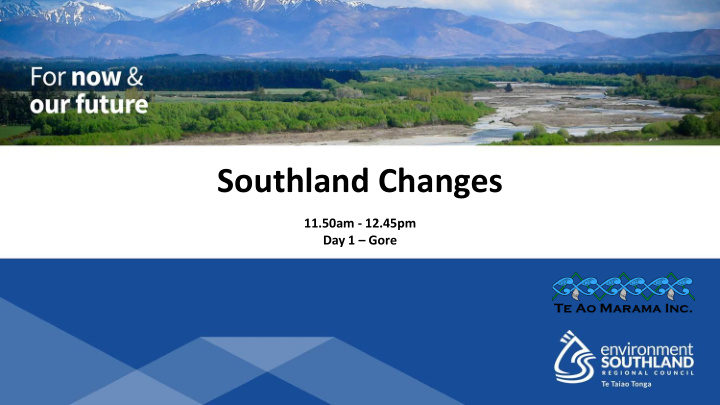



Southland Changes 11.50am - 12.45pm Day 1 – Gore
Brief History Early Māori – burning to encourage edible plants and make travel easier European settlers – deforested vast areas, attempted to ‘tame’ the land 1860s – gold rush Sediment Factory wastes 1882- Dunedin shipping frozen meat Pathogens - typhoid 1930s – “breaking in” of hill country 1949 – aerial topdressing of superphosphate Sediment with increased phosphorus 1966-1975 – NZs first regional water quality classification system 1972 – basic 2-pond effluent treatment systems 1982 – urea plant opened in Taranaki Longer grass growing season supports intensification and expansion of dairy farming
Riverton Canton Village late 1880s Wheat loading, Waimea Plains ~1899 Mataura’s first ( shortlived) bridge, 1913
Colonist, 18 August 1883 These modest tents were the only facilities for treating a typhoid outbreak in Te Urewera in 1924. Typhoid fever was always a threat in remote localities that lacked reliable means for separating water supply and human waste. Alexander Turnbull Library, Sister Annie Henry Collection (PAColl-6098). Reference:1/2-030884
Deforestation McGlone (2004)
Wetland loss date? 2015
Brief Planning History 1900s – Dept. of Public Health established 1953 – Pollution Advisory Council created Pathogens 1967 – National Water and Soil Conservation Authority established Factory wastes 1969 – “Save the Manapouri ” campaign starts Growth of environmental awareness 1984 – economic restructuring and major Invercargill flood 1991 – Resource Management Act 2011 – NPS Freshwater Mgmt. More robust regulation developed
Regional Changes 1919 – Southland Electric Power Board formed
River cuts and flood channels
1984: Upheaval
1996
1997
1998
1999
2000
2001
2002
2003
2004
2005
2006
2007
2008
2009
2010
2011
2012
2013
2014
2015
2016
Engaged communities
Mataura Catchment “…The Mataura River is fully committed carrying a full load of trade and human wastes out to sea. This situation has developed in an area where it is our proud boast that we have ample rainfall, fairly evenly spread over the year. The worst feature of this is that as yet only a handful of people are aware of this situation and even fewer are concerned about it”. Dugald McKenzie in his 1977 presidential address to the Catchment Authorities’ Association
• 1925 Water supply opened • 1973 & 1982 Wastewater treatment schemes established • 1984 Mataura WCO applications • 1997 WCO come into force 2013 - Matāura River Art Project
• What do we monitor where? • What do the results tell us?
Types of monitoring programmes • Long-term (state of the environment) – Required under the RMA – Sites selected to represent broader areas • Investigations – Target specific activities or catchment pressure points – Shorter duration
What do we monitor? Periphyton (slime algae) including cyanobacteria Physical and chemical Macroinvertebrates characteristics of water (insects, worms and snails) Fish Microbial indicators Estuaries (pathogens) Broad & fine scale monitoring
Where and how often? Sites: Mataura River 200m d/s Mataura Bridge Mimihau Stream Trib at Venlaw Forest Mimihau Stream at Wyndham Mokoreta River at Wyndham River Road Oteramika Stream at Seaward Downs Mataura River at Mataura Island Bridge Long-term monthly water quality monitoring began 1996 Biomonitoring mostly occurs annually
Recommend
More recommend